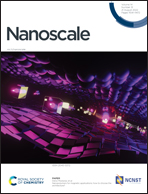Effects of hydrophilic fullerene nanoarchitectured structures on the behaviour of neural stem cells†
Abstract
The interaction between nanoarchitectonic fullerenes and cells is essential for their applications in the biological field. Herein we reported the preparation and investigation of the function of different types of water-dispersible self-assembled fullerenes. The hydrophobic self-assembled fullerenes were either surface-modified or chemically etched to become water dispersible. Different types of fullerenes were then examined for their effects on the behavior of neural stem cells (NSCs). Our results indicated that only the hydrophilic fullerene nanotubes (FNTs, diameter ∼480 nm) created by chemically etching were endocytosed by NSCs, which showed a spindle-like morphology after the uptake. Meanwhile, the FNTs did not increase the reactive oxygen species (ROS) production of the cells. The expression levels of neural-related genes (CNPase and β-tubulin) were upregulated 1.5-fold in the presence of FNTs. The differentiation of NSCs depended on the size, shape, and surface functional group of various fullerenes. Besides, the addition of FNTs in a chitosan self-healing hydrogel did not influence the integrity, injectability, and self-healing properties of the composite hydrogel. These results revealed that FNTs induced the neural differentiation of NSCs in the composite hydrogel. The addition of FNTs at a low concentration (50 μg mL−1) was enough to create such effects in the composite hydrogel. The expression levels of the oligodendrocytic marker gene CNPase and the neuronal marker gene β-tubulin were increased remarkably by ∼14.5- and ∼8.4-fold, respectively, by the composite self-healing hydrogel containing 50 μg mL−1 FNTs. The fullerene nanoarchitectured structures may have potential for use as nanovehicles and in neural tissue engineering in the future.

- This article is part of the themed collection: Design and function of materials nanoarchitectonics


 Please wait while we load your content...
Please wait while we load your content...